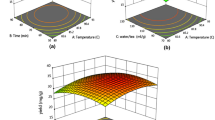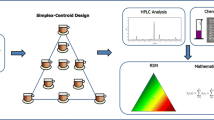Summary
The simultaneous influence of pH and composition of water–ethanol mixtures on the extraction from tea of caffeine (CF), gallic acid (GA) and the selected catechins epicatechin (EC), epicatechin-3-gallate (ECG) and epigallocatechin-3-gallate (EGCG) is investigated by response surface methodology. Extraction experiments are carried out at room temperature according to a three-level full-factorial design in which pH, measured before mixing with ethanol, is varied between 6 and 8 and volume fraction of ethanol is varied between 30 and 70 % v/v. Response surfaces are determined by fitting of extracted amounts of the above substances, determined by HPLC analysis, with a second-degree polynomial model. Within the investigated experimental domain, extraction efficiency of CF is substantially the same and extraction of ECG and EGCG is not affected by acidity of the medium while both pH and composition influence the extraction of EC and GA.




Similar content being viewed by others
References
Beltrán JL, Sanli N, Fonrodona G, Barrón D, Özkanb G, Barbosa J (2003) Spectrophotometric, potentiometric and chromatographic pKa values of polyphenolic acids in water and acetonitrile-water media. Anal Chim Acta 484:253–264
Bezerra MA, Santelli RE, Oliveira EP, Villar LS, Escaleira LA (2008) Response surface methodology (RSM) as a tool for optimization in analytical chemistry. Talanta 76:965–977
Candioti LV, De Zan MM, Cámara MS, Goicoechea HC (2014) Experimental design and multiple response optimization. Using the desirability function in analytical methods development. Talanta 124:123–138
Ferruzzi MG, Green RJ (2006) Analysis of catechins from milk-tea beverages by enzyme assisted extraction followed by high performance liquid chromatography. Food Chem 99:484–491
Forina M, Lanteri S, Armanino C, Casolino C, Casale M, Oliveri P, V-PARVUS 2010. Dip. Chimica e Tecnologie Farmaceutiche ed Alimentari, University of Genova, http://www.parvus.unige.it
Heinisch S, Rocca JL (2004) Effect of mobile phase composition, pH and buffer type on the retention of ionizable compounds in reversed-phase liquid chromatography: application to method development. J Chromatogr A 1048:183–193
Hu C-J, Gao Y, Liu Y, Zheng X-Q, Ye J-H, Liang Y-R, Lu J-L (2016) Studies on the mechanism of efficient extraction of tea components by aqueous ethanol. Food Chem 194:312–318
Hu J, Zhou D, Chen Y (2009) Preparation and antioxidant activity of green tea extract enriched in epigallocatechin (EGC) and epigallocatechin gallate (EGCG). J Agric Food Chem 57:1349–1353
Jokić S, Cvjetko M, Božić Ð, Fabek S, Toth N, Vorkapić-Furač J, Radojčić RI (2012) Optimisation of microwave-assisted extraction of phenolic compounds from broccoli and its antioxidant activity. International Journal of Food Science & Technology 47:2613–2619
Juntachote T, Berghofer E, Bauer F, Siebenhandl S (2006) The application of response surface methodology to the production of phenolic extracts of lemon grass, galangal, holy basil and rosemary. International Journal of Food Science & Technology 41:121–133
Kao YH, Chang HH, Lee MJ, Chen CL (2006) Tea, obesity, and diabetes. Molecular Nutrition & Food ResearchMol 50:188–210
Khan N, Mukhtar H (2007) Tea polyphenols for health promotion. Life Sci 81:519–533
Labbé D, Tremblay A, Bazinet L (2006) Effect of brewing temperature and duration on green tea catechin solubilization: basis for production of EGC and EGCG-enriched fractions. Sep Purif Technol 49:1–9
Leardi R (2009) Experimental design in chemistry: a tutorial. Anal Chim Acta 652:161–172
Lee KJ, Lee SH (2008) Extraction behavior of caffeine and EGCG from green and black tea. Biotechnol Bioprocess Eng 13:646–649
Lee L-S, Lee N, Kim YH, Lee C-H, Hong SP, Jeon Y-W, Kim Y-E (2013) Optimization of ultrasonic extraction of phenolic antioxidants from green tea using response surface methodology. Molecules 18:13530–13545
Liang H, Liang Y, Dong J, Lu J (2007) Tea extraction methods in relation to control of epimerization of tea catechins. J Sci Food Agric 87:1748–1752
Liang Y, Xu Y (2001) Effect of pH on cream particle formation and solids extraction yield of black tea. Food Chem 74:155–160
Lu L-L, Lu X-Y (2007) Solubilities of gallic acid and its esters in water. Journal of Chemical and Engineering Data 52:37–39
Muzolf-Panek M, Gliszczyńska-Świgło A, Szymusiak H, Tyrakowska B (2012) The influence of stereochemistry on the antioxidant properties of catechin epimers. Eur Food Res Technol 235:1001–1009
Nehlig A, Daval JL, Debry G (1992) Caffeine and the central nervous system: mechanisms of action, biochemical, metabolic and psychostimulant effects. Brain Res Rev 17:139–169
Perva-Uzunalić A, Škerget M, Knez Ž, Weinreich B, Otto F, Grüner S (2006) Extraction of active ingredients from green tea (Camellia sinensis): extraction efficiency of major catechins and caffeine. Food Chem 96:597–605
Rived F, Canals I, Bosch E, Rosés M (2001) Acidity in methanol–water. Anal Chim Acta 439:315–333
Rosés M (2004) Determination of the pH of binary mobile phases for reversed-phase liquid chromatography. J Chromatogr A 1037:283–298
Rosés M, Rived F, Bosch E (2000) Dissociation constants of phenols in methanol-water mixtures. J Chromatogr A 867:45–56
Rusak G, Komes D, Likić S, Horžić D, Kovač M (2008) Phenolic content and antioxidative capacity of green and white tea extracts depending on extraction conditions and the solvent used. Food Chem 110:852–858
Sajilata MG, Bajaj PR, Singhal RS (2008) Tea polyphenols as nutraceuticals. Comprehensive Reviews in Food Science and Food Safety 7:229–254
Trevisanato SI, Kim YI (2000) Tea and health. Nutr Rev 58:1–10
Vuong QV, Golding JB, Nguyen M, Roach PD (2010) Extraction and isolation of catechins from tea. J Sep Sci 33:3415–3428
Vuong QV, Golding JB, Stathopoulos CE, Roach PD (2013) Effects of aqueous brewing solution pH on the extraction of the major green tea constituents. Food Res Int 53:713–719
Vuong QV, Stathopoulos CE, Nguyen MH, Golding JB, Roach PD (2011) Isolation of green tea catechins and their utilization in the food industry. Food Reviews International 27:227–247
Wheeler DS, Wheeler WJ (2004) The medicinal chemistry of tea. Drug Dev Res 61:45–65
Yang L, Cao Y-L, Jiang J-G, Lin Q-S, Chen J, Zhu L (2010) Response surface optimization of ultrasound-assisted flavonoids extraction from the flower of Citrus aurantium L. var. amara Engl. J Sep Sci 33:1349–1355
Ye J-H, Li N-N, Lu J-L, Zheng X-Q, Liang Y-R (2014) Bulk preparation of (−)-epigallocatechin gallate-rich extract from green tea. Food and Bioproducts Processing 92:275–281
Yoshida Y, Kiso M, Goto T (1999) Efficiency of the extraction of catechins from green tea. Food Chem 67:429–433
Zimmermann BF, Gleichenhagen M (2011) The effect of ascorbic acid, citric acid and low pH on the extraction of green tea: how to get most out of it. Food Chem 124:1543–1548
Author information
Authors and Affiliations
Corresponding author
Ethics declarations
Conflict of Interest
Angelo A. D’Archivio declares that he has no conflict of interest. Maria A. Maggi declares that she has no conflict of interest. Fabrizio Ruggieri declares that he has no conflict of interest.
Ethical Approval
This article does not contain any studies with human participants or animals performed by any of the authors.
Informed Consent
Not applicable.
Rights and permissions
About this article
Cite this article
D’Archivio, A.A., Maggi, M.A. & Ruggieri, F. Investigation by Response Surface Methodology of Extraction of Caffeine, Gallic Acid and Selected Catechins from Tea Using Water-Ethanol Mixtures. Food Anal. Methods 9, 2773–2779 (2016). https://doi.org/10.1007/s12161-016-0469-7
Received:
Accepted:
Published:
Issue Date:
DOI: https://doi.org/10.1007/s12161-016-0469-7




